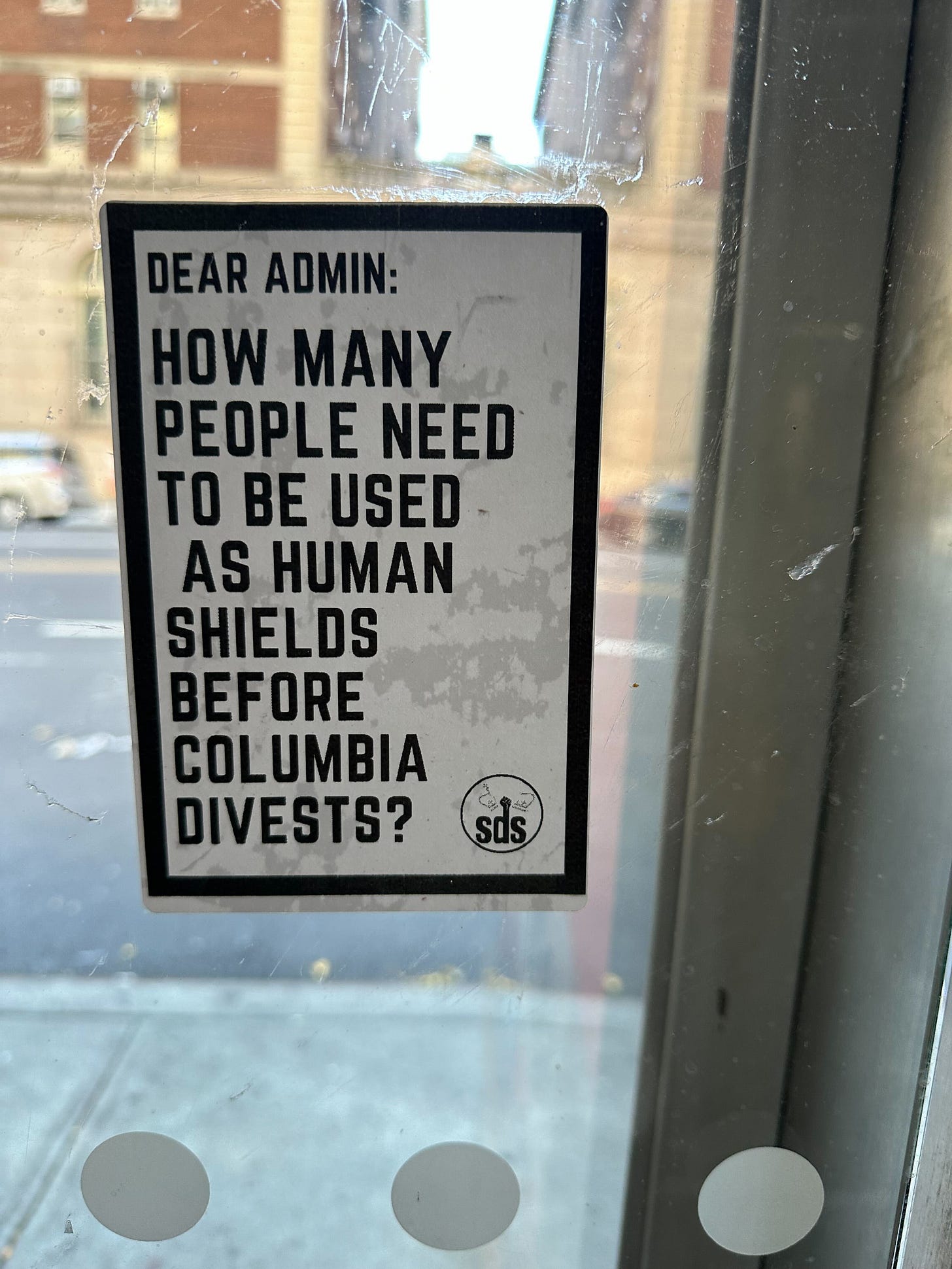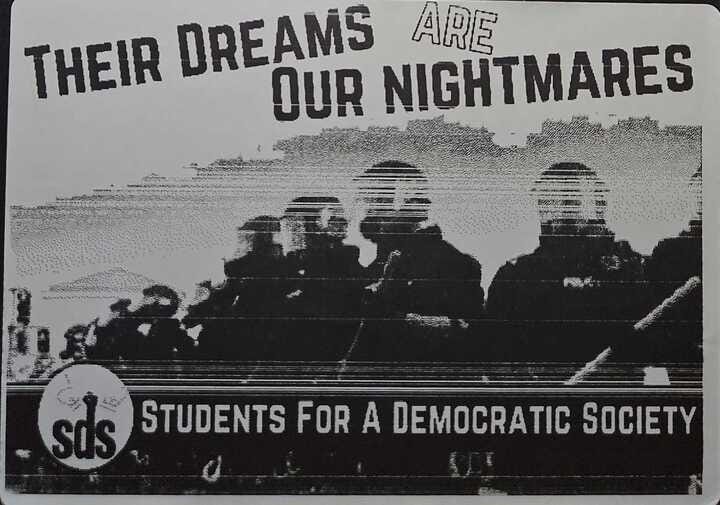The Return of Students for a Democratic Society
The revived campus group plans to disrupt “Zionist events” and target the University’s “pressure points.”
You may have noticed a barrage of stickers almost everywhere in Morningside Heights, both inside and outside Columbia’s gates.
These stickers, with the slogans “Globalise the Intifada” and “Resist This Fascist,” adorn everything from dorm elevators and bus stops to trash cans and campus buildings. They have two things in common: highly evocative language, and three letters that, for better or worse, have radically shaped Columbia: SDS.
Students for a Democratic Society spearheaded the 1968 Columbia protests and were largely responsible for bringing the New Left to the University. Now, the name seems to have been revived for similar purposes.
But who is the new SDS, and what do they want? The group’s Propaganda and Outreach Committee, which controls SDS’ messaging, priorities, and tactics, highlights three main issue areas: Palestine, Donald Trump, and the University.
Palestine
Even though Israel and Hamas signed a (fragile) ceasefire agreement on January 17, 2025, with the hope of ending the current war, SDS aims to center Palestine as an intersectional cause for all globally oppressed peoples.
“There are also going to be potential Zionist events, which we can highlight or disrupt,” an SDS leader named Gabriel said at the group’s new member meeting on January 28.
Disrupting of “Zionist events” is a frequent tactic of anti-Israel groups on campus: At the start of the spring 2025 semester, several protestors disrupted the History of Modern Israel seminar, handing out flyers saying “Burn Zionism to the Ground,” although it is unclear if SDS was involved.
“The first main issue is Palestine, which was our main focus last semester,” Gabriel said at the January 28 meeting. “There are probably going to be a lot more rallies and attempts to bring pressure to the University.”
Donald Trump
Second, the group opposes President Trump and the flurry of executive orders he has issued during his first month in office. “Trump's putting out a lot of shit, and trying to parse out what it all means in practical terms for people is something that we can do as an organization with a bit of a name,” Gabriel said.
Leaders also said that SDS can promote initiatives other groups cannot, such as promoting “ICE watch” videos, which the Democratic Party cannot do because “that would be promoting defiance of the law,” Gabriel said. Similarly, he said that while Columbia’s Young Democratic Socialists of America (YDSA) chapter can criticize Trump’s policies, they can’t take “as direct action against them as we can.” SDS will still collaborate with organizations like YDSA “because they get funding from Columbia workspaces.”
The University
None of this is to say they are on good terms with the University they represent. SDS stands in direct opposition to Columbia and its bureaucracy, claiming it has been weaponized and citing the “continued and rapid increase of campus surveillance.” The group claims that the administration has weaponized the Office of Institutional Equity (OIE)—responsible for the “review and arbitration of all reports of discrimination and discriminatory harassment at Columbia”—to target pro-Palestinian protestors.
Columbia is currently under investigation by the Department of Education’s Office for Civil Rights for allegations of both anti-Palestinian discrimination and antisemitism.
SDS leaders said they plan to target the University’s “pressure points” via the media and protests: “the Trustees, loopholes, and Barnard,” the latter chosen for its poor financial situation and smaller endowment relative to Columbia.
Leaders also positioned SDS as part of a broader network of campus groups and envisioned themselves as part of the coalitional structure of the pro-Palestine movement. In November, the group considered then tabled a motion to join the Columbia Palestine Solidarity Coalition (CPSC), asplinter group from Columbia University Apartheid Divest (CUAD), according to their public meeting notes. SDS continues to support CUAD and Columbia Students for Justice in Palestine, and believe that CUAD is “the only organization that can do rallies.”
Additionally, SDS has a dedicated Union Committee that helped create the Columbia University Student Union in collaboration with other organizations this semester. The union is “dedicated to building participatory and democratic student power to counter the university’s undemocratic governance,” according to its constitution.
“For too long, the university administration and board of trustees have unilaterally dictated policy without accountability to their constituents. We believe the policies and structure of the university should reflect the needs and values of its students, faculty, and staff, as well as answer the call of education instead of the demands of profit,” they wrote in their mission statement.
“Students of this university are in a ground hog day scenario. We build coalitions, people are arrested, and movement is killed,” they wrote in their notes from their February 6 mass meeting in Lerner Hall.
Thus, like SDS the union plans to “directly contest the university.” Their spin, however, is a fiscal angle—they plan to advocate for the REPAIR Act, a bill in the New York State Legislature that, if enacted, would revoke Columbia’s and NYU’s tax-exempt statuses with the goal of funding public universities in New York City.
The union will also help to provide support for “suspended students” and “people dealing with consequences for protests” by combating alleged University surveillance. And, like SDS, they hope to make Columbia students “collectively feel more upset.”
SDS in Fall 2024
Columbia’s current SDS chapter started last semester and is part of a national movement founded in 2006 to protest the American invasions of Iraq and Afghanistan. “We stand against US wars and intervention, racist discrimination, police crimes, homophobic and transphobic attacks, attacks on women, attacks on reproductive rights, and much, much more,” the national organization states on their website.
During the fall 2024 semester, Columbia SDS primarily focused on the Israel-Hamas War. On October 7, 2024—the one-year anniversary of the October 7 terrorist attacks—the chapter organized a joint walkout with the NYU chapter, declaring “NO SCHOOL AS USUAL DURING A GENOCIDE!” on Instagram.
Later that month, the chapter covered several bulletin boards across campus with “Walls of Shame” featuring quotes from Israeli officials that SDS views as displaying “genocidal intent.”
According to SDS’ meeting minutes, the group was involved in organizing “Hind’s House,” a November 2024 teach-in and exhibition at the Alpha Delta Phi brownstone. The event featured artifacts and images from the spring 2024 takeover of Hamilton Hall, including some of the tools used during the break-in. Also inside were items like headbands with the logo of the Popular Front for the Liberation of Palestine (PFLP), a U.S.-designated terrorist organization, and a poster glorifying the paragliders used by Hamas terrorists in the October 7 attacks.
As for the stickers, at the January 28 meeting Columbia SDS claimed to have distributed 120,000 to date. Minutes from an October meeting say it is “empowering to be able to cover up Zionist propaganda.”
SDS also organized a rally against Donald Trump on November 8, 2024. Meeting notes from November 6 mention that some members believed the rally could “build community via action” and that it would be beneficial to stage a “physical rally oriented around common enemy.”
Columbia SDS did not respond to a request for comment.
The old SDS and the 1968 protests
The original Students for a Democratic Society was established in 1962 by Tom Hayden, then an undergraduate at the University of Michigan. The movement's manifesto, the Port Huron Statement, implored that “uncomfortable personal efforts” must be used to create meaningful change, including radical protests. Columbia was the 52nd chapter of SDS and initially kept a low profile while steadily building its membership throughout the 1960s.
In 1968, many students were disgusted by the University’s involvement with the Institute for Defense Analyses through which universities and the U.S. government collaborated on military research. This complaint was only one of many catalysts for the ’68 protests. The immediate trigger was something much more tangible: The planned construction of a gym in Morningside Park which activists believed segregated out Harlem residents. After the construction plans were publicized, SDS quickly organized a rally at the Sundial, setting the sporadic events of the ’68 protests in motion, culminating in the occupation of Hamilton Hall that ended with over 700 arrests.
We at Sundial know the power of revived groups—we are one ourselves. Whether the new Columbia SDS will be an agent of chaos or of constructive criticism remains to be seen—they simultaneously promise not to break university rules while also planning to disrupt “Zionist” events. But if SDS can welcome itself to outsiders and express their ideas in a productive and responsible manner, they have the potential to be a valuable addition to campus discourse by encouraging critical thinking on Columbia’s past and future.
Mr. Engel is a senior at Columbia College studying history and a senior staff writer for Sundial.





